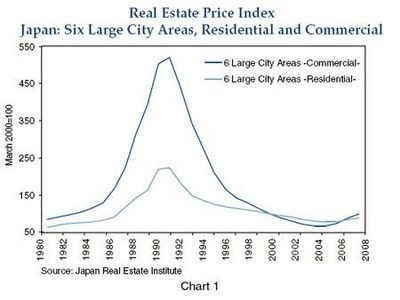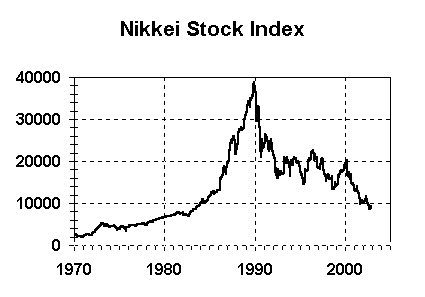By Jesse Colombo (This article was written on May 9th, 2012)
Can an economic crisis last for two decades? Yes – this is exactly what happened to Japan after the Japanese Bubble Economy popped in 1990.
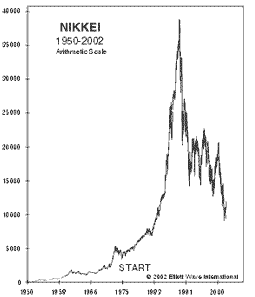 After World War II, Japan was devastated – several of its major cities were obliterated and its economy was a mere shadow of its former self. After much hard work and sacrifice, the Japanese economy began to slowly stabilize and recover. Additionally, the United States government’s Marshall Plan helped Japan to rebuild and provided capital and military protection as well. The value of military protection should not be overlooked as this is usually the highest expense of any government. This savings allowed the Japanese economy and government run more freely and efficiently.
After World War II, Japan was devastated – several of its major cities were obliterated and its economy was a mere shadow of its former self. After much hard work and sacrifice, the Japanese economy began to slowly stabilize and recover. Additionally, the United States government’s Marshall Plan helped Japan to rebuild and provided capital and military protection as well. The value of military protection should not be overlooked as this is usually the highest expense of any government. This savings allowed the Japanese economy and government run more freely and efficiently.
Factories were quickly built and peasants became factory workers. Middle and upper class men became white collar workers, called “salarymen.” Japanese salarymen and factory workers were offered lifetime employment, which encouraged workers to be fiercely loyal to their employers. Most Japanese workers lived very frugally, saving a large portion of their earnings.
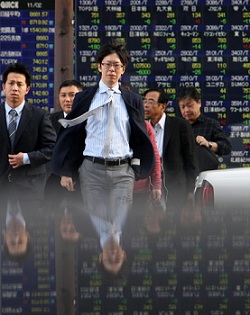 Many companies merged together to become large industrial and banking conglomerates called zaibatsu. The zaibatsu conglomerates gained a competitive edge through copying and improving Western products and selling them back to the West for lower prices. Japan’s inexpensive products won Western customers and began to pose a serious competitive threat to American companies. Japan’s rapid economic growth allowed the zaibatsu conglomerates to evolve into even larger business conglomerates called keiretsu. The keiretsu philosophy was one of cooperation, where all facets of business and government worked hand-in-hand, though Western critics considered this business arrangement to be a form of crony capitalism and called it “Japan, Inc.” As the Japanese stock market soared, the keiretsu purchased each other’s shares to form extensive networks of cross-holdings.
Many companies merged together to become large industrial and banking conglomerates called zaibatsu. The zaibatsu conglomerates gained a competitive edge through copying and improving Western products and selling them back to the West for lower prices. Japan’s inexpensive products won Western customers and began to pose a serious competitive threat to American companies. Japan’s rapid economic growth allowed the zaibatsu conglomerates to evolve into even larger business conglomerates called keiretsu. The keiretsu philosophy was one of cooperation, where all facets of business and government worked hand-in-hand, though Western critics considered this business arrangement to be a form of crony capitalism and called it “Japan, Inc.” As the Japanese stock market soared, the keiretsu purchased each other’s shares to form extensive networks of cross-holdings.
The oil crisis and inflation of the 1970s threatened the U.S. economy and American cars, with their gas-guzzling V8 engines, became increasingly expensive to run. Japanese car makers such as Honda and Datsun (now called Nissan) quickly mobilized to produce and export small fuel-efficient cars that cost less than American cars. The quality of Japanese automobiles increased at a very high rate, especially after Japanese automobile manufacturers began to use assembly-line robots to build cars, which made human error nonexistant. The potent competition from Japanese automakers contributed to the long-term decline of the American automobile industry. While Japanese companies were increasing their business fortunes around the world, Japan’s Nikkei stock average was soaring to incredible new heights.
By the late 1970s, Japanese companies added electronics manufacturing to their list of specialties. Japanese keiretsu corporations such as Hitachi and Sony copied and produced quality electronics hardware needed by the growing global computer industry. Japanese companies soon trounced American companies in the electronics and computer hardware manufacturing arena due to their 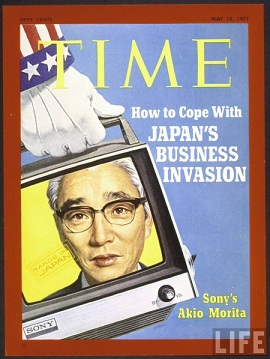 ability to successfully compete on price, aided by robots and cheap labor. With the exception of CPU microprocessors, Japan dominated the market for all chips, circuit boards and other components. During this time, it was widely believed that Japanese electronics powerhouses Sony and Hitachi would eventually acquire Intel and IBM.
ability to successfully compete on price, aided by robots and cheap labor. With the exception of CPU microprocessors, Japan dominated the market for all chips, circuit boards and other components. During this time, it was widely believed that Japanese electronics powerhouses Sony and Hitachi would eventually acquire Intel and IBM.
By the late 1980s, Japan became viewed as a practical utopia because its people had one of the highest qualities of life in the world and the world’s longest life expectancy. Japan soon became the world’s largest net creditor nation and had among the world’s highest GDPs per capita. Many Americans feared that their society and workforce would become obsolete due to Japan’s high technology, especially their robotic technology. As the Japanese economy and stock market boomed, many new skyscrapers were builted in the cities of Tokyo and Osaka. Enthusiasm over Japan’s real estate market caused prices to skyrocket along with the nation’s stocks. Between 1986 and 1988, the price of commercial land in greater Tokyo approximately doubled. Real estate prices rose to such a high level that the land in Tokyo alone was worth more than all of the land in the United States. Between 1955 and 1990, land prices in Japan appreciated 70 times and stocks increased 100 times over. An average home near Tokyo cost well over $2 million in 1989. Large-scale stock speculation occurred and escalated into a full-blown mania. By the peak of Japan’s bubble, investors from across the entire world were vying to buy Japanese shares; these euphoric investors believed in the fallacy of a perpetual bull market. As stock and real estate prices soared to stratospheric levels, newly-wealthy investors purchased incredible amounts of luxury goods and famous works of art and even created an art bubble.
When Japan’s asset prices continued to soar in 1989, policy makers became increasingly worried about asset bubbles. To cool the overheating economy, the Bank of Japan increased their interest rates. In less than a year, Japan’s Nikkei stock index plunged by 50% from approximately 39,000 to 20,000 and finally hit 15,000 by 1992.The Nikkei’s dramatic crash occurred because its value was inflated by false hopes and hype instead of being based upon solid economics. As the financial crisis unfolded, many corporate scandals came to light.
Japan’s government and corporations are still suffering under the weight of crushing debt loads that have accumulated since the late 1980’s. After two decades, Japan’s economy is still in the doldrums and their real estate prices have plummeted for just as long and are likely to continue falling in the future. The story of Japan’s bubble economy and its subsequent crash should be a lesson to all nations to avoid allowing economic bubbles to form at all costs.
Other Japanese Bubble Economy Resources:
Japan’s Bubble Economy of the 1980s
Wikipedia: Japanese asset price bubble
Wikipedia: Japanese post-war economic miracle
Life After the Bubble: How Japan Lost a Decade
Wikipedia: Lost Decade (Japan)
Questions? Comments?


